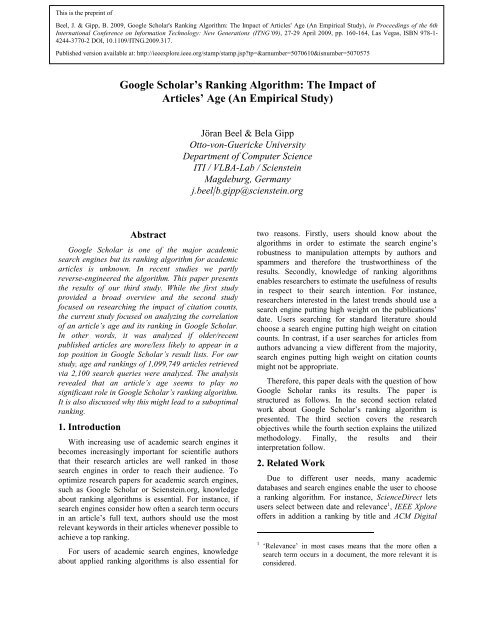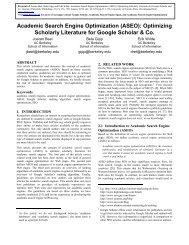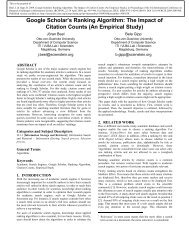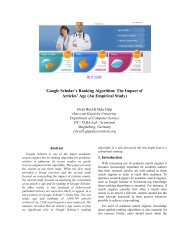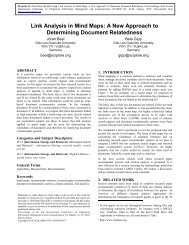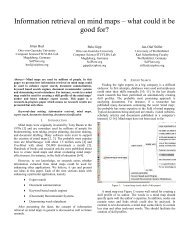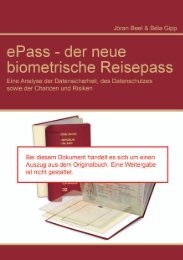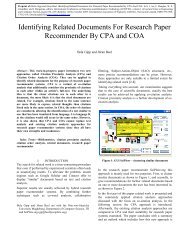Google Scholar's Ranking Algorithm: The Impact of ... - SciPlore
Google Scholar's Ranking Algorithm: The Impact of ... - SciPlore
Google Scholar's Ranking Algorithm: The Impact of ... - SciPlore
Create successful ePaper yourself
Turn your PDF publications into a flip-book with our unique Google optimized e-Paper software.
This is the preprint <strong>of</strong>Beel, J. & Gipp, B. 2009, <strong>Google</strong> <strong>Scholar's</strong> <strong>Ranking</strong> <strong>Algorithm</strong>: <strong>The</strong> <strong>Impact</strong> <strong>of</strong> Articles' Age (An Empirical Study), in Proceedings <strong>of</strong> the 6thInternational Conference on Information Technology: New Generations (ITNG’09), 27-29 April 2009, pp. 160-164, Las Vegas, ISBN 978-1-4244-3770-2 DOI, 10.1109/ITNG.2009.317.Published version available at: http://ieeexplore.ieee.org/stamp/stamp.jsp?tp=&arnumber=5070610&isnumber=5070575<strong>Google</strong> Scholar’s <strong>Ranking</strong> <strong>Algorithm</strong>: <strong>The</strong> <strong>Impact</strong> <strong>of</strong>Articles’ Age (An Empirical Study)Jöran Beel & Bela GippOtto-von-Guericke UniversityDepartment <strong>of</strong> Computer ScienceITI / VLBA-Lab / SciensteinMagdeburg, Germanyj.beel|b.gipp@scienstein.orgAbstract<strong>Google</strong> Scholar is one <strong>of</strong> the major academicsearch engines but its ranking algorithm for academicarticles is unknown. In recent studies we partlyreverse-engineered the algorithm. This paper presentsthe results <strong>of</strong> our third study. While the first studyprovided a broad overview and the second studyfocused on researching the impact <strong>of</strong> citation counts,the current study focused on analyzing the correlation<strong>of</strong> an article’s age and its ranking in <strong>Google</strong> Scholar.In other words, it was analyzed if older/recentpublished articles are more/less likely to appear in atop position in <strong>Google</strong> Scholar’s result lists. For ourstudy, age and rankings <strong>of</strong> 1,099,749 articles retrievedvia 2,100 search queries were analyzed. <strong>The</strong> analysisrevealed that an article’s age seems to play nosignificant role in <strong>Google</strong> Scholar’s ranking algorithm.It is also discussed why this might lead to a suboptimalranking.1. IntroductionWith increasing use <strong>of</strong> academic search engines itbecomes increasingly important for scientific authorsthat their research articles are well ranked in thosesearch engines in order to reach their audience. Tooptimize research papers for academic search engines,such as <strong>Google</strong> Scholar or Scienstein.org, knowledgeabout ranking algorithms is essential. For instance, ifsearch engines consider how <strong>of</strong>ten a search term occursin an article‟s full text, authors should use the mostrelevant keywords in their articles whenever possible toachieve a top ranking.For users <strong>of</strong> academic search engines, knowledgeabout applied ranking algorithms is also essential fortwo reasons. Firstly, users should know about thealgorithms in order to estimate the search engine‟srobustness to manipulation attempts by authors andspammers and therefore the trustworthiness <strong>of</strong> theresults. Secondly, knowledge <strong>of</strong> ranking algorithmsenables researchers to estimate the usefulness <strong>of</strong> resultsin respect to their search intention. For instance,researchers interested in the latest trends should use asearch engine putting high weight on the publications‟date. Users searching for standard literature shouldchoose a search engine putting high weight on citationcounts. In contrast, if a user searches for articles fromauthors advancing a view different from the majority,search engines putting high weight on citation countsmight not be appropriate. googlexxxfods<strong>The</strong>refore, this paper deals with the question <strong>of</strong> how<strong>Google</strong> Scholar ranks its results. <strong>The</strong> paper isstructured as follows. In the second section relatedwork about <strong>Google</strong> Scholar‟s ranking algorithm ispresented. <strong>The</strong> third section covers the researchobjectives while the fourth section explains the utilizedmethodology. Finally, the results and theirinterpretation follow.2. Related WorkDue to different user needs, many academicdatabases and search engines enable the user to choosea ranking algorithm. For instance, ScienceDirect letsusers select between date and relevance 1 , IEEE Xplore<strong>of</strong>fers in addition a ranking by title and ACM Digital1 „Relevance‟ in most cases means that the more <strong>of</strong>ten asearch term occurs in a document, the more relevant it isconsidered.
Citation Count (Ordinal)YearLibrary allows users to choose whether to sort resultsby relevance, publication date, alphabetically by title orjournal, citation counts or downloads. However, these„algorithms‟ can be considered trivial since users canselect only one ranking criteria and are not allowed touse a (weighed) combination <strong>of</strong> them.1201008060402000 250 500 750 1000Position in <strong>Google</strong> ScholarFigure 1: Mean Citation Count<strong>Google</strong> Scholar is one <strong>of</strong> the few academic searchengines combining several approaches in a singlealgorithm 2 . Several studies about <strong>Google</strong> Scholar exist.For instance, about data overlap with other academicsearch engines such as Scopus and Web <strong>of</strong> Science[1], [2], <strong>Google</strong> Scholar‟s coverage <strong>of</strong> the literature ingeneral and in certain research fields [3], [4], thesuitability to use <strong>Google</strong> Scholar‟s citation counts forcalculating googlexxx99gs bibliometric indices such as the h-index [5]and the reliability <strong>of</strong> <strong>Google</strong> Scholar as a seriousgooglexxx99654rinformation source in general [6], [7]. <strong>Google</strong> Scholaritself googlexxx645g publishes only vague information about itsranking algorithm: <strong>Google</strong> Scholar sorts “articles theway researchers do, weighing the full text <strong>of</strong> eacharticle, the author, the publication in which the articleappears, and how <strong>of</strong>ten the piece has been cited inother scholarly literature” [8]. Any other details orfurther explanation is not available.Although <strong>Google</strong> Scholar‟s ranking algorithm has asignificant influence on which academic articles areread by the scientific community, we could not find anystudies about <strong>Google</strong> Scholar‟s ranking algorithmdespite our own ones [9], [10]. From our previousstudies we know that<strong>Google</strong> Scholar‟s ranking algorithm puts highweight on words in the title.2 Others are, for instance, CiteSeer and Scienstein.org [11,12]2004200220001998199619941992199019881986<strong>Google</strong> Scholar considers only those wordsthat are directly included in an article anddoes not consider synonyms <strong>of</strong> those words.<strong>Google</strong> Scholar seems to put no or low weighton the frequency with which search termsoccur in the full text. That means an articlewill not be ranked higher for a certain searchjust because the search term occurs frequentlyin the full text.<strong>Google</strong> Scholar is not indexing text embeddedvia pictures.<strong>Google</strong> Scholar uses different rankingalgorithms for a keyword search in the fulltext, keyword search in the title, the „relatedarticles‟ function and the „cited by‟ function.<strong>Google</strong> Scholar‟s ranking algorithm puts highweight on author and journal names.<strong>Google</strong> Scholar‟s ranking algorithm weighsheavily on articles‟ citation counts (see Figure1), whereas different patterns werediscovered.Mean0 250 500 750 1000Position in Result ListFigure 2: Mean Publication Year per PositionSince citation counts have a strong impact on<strong>Google</strong> Scholar‟s rankings, one could assume that olderarticles are found more <strong>of</strong>ten in top positions, sinceolder publications naturally have had more time to becited. As a consequence, this practice would strengthenthe Matthew Effect 3 . To counteract the Matthew Effectand since one might assume that most researchers havean interest in the most recent research results rather3 <strong>The</strong> Matthew Effect describes that well known authors aremore <strong>of</strong>ten cited just because they are well known [13].Related to search engines this means: Articles with manycitations will be more likely displayed in top positions,therefore get more readers and receive more citations,which then consolidate their lead over lesser cited articles.
Publication YearPublication YearPublication YearPublication YearPublication YearHowever, looking at the average age, anotherimpression evolves. Figure 6 displays the averagepublication year (mean) for each position in <strong>Google</strong>Scholar. It shows clearly that in the top positionsarticles are on average older than articles in theremaining positions 6 .A look at the numbers confirms this assumption.While those papers ranked in position 1 by <strong>Google</strong>Scholar were on average published in 1992, papers onposition 5 were on average published in 1993, paperson position 100 in 1994 and papers on position 500 in1995 (see Table 3). Graphs for title-searches looksimilar (see Figure 7) and no significant differencesoccurred between single-word, double word and tripleword search queries 7 .20082003199819931988198319781973196819631958200820031998199319881983197819731968196319580 200 400 600 800 1000Position in <strong>Google</strong> ScholarFigure 3: Search Query 'Future'0 200 400 600 800 1000Position in <strong>Google</strong> ScholarFigure 4: Search Query '<strong>Google</strong> Scholar'20082003199819931988198319781973196819630 200 400 600 800 1000Position in <strong>Google</strong> ScholarFigure 5: Search Query 'Climate Change Discussion'1997199619951994199319921991199019890 200 400 600 800 1000Position in <strong>Google</strong> ScholarFigure 6: Mean Publication Year (Full-Text Search)Table 3: Mean Publication Year (Selected Positions)PositionPublicationYear (Mean) PositionPublicationYear (Mean)1 1992 10 19942 1992 50 19943 1992 100 19944 1993 250 19945 1993 500 1995199619951994than from decades before. However, this is out <strong>of</strong> thecurrent study‟s scope.6 Graphs for the modal and median publication year showsimilar pictures.7 In all graphs, some outliers can be observed in the very lastpositions. This is due to <strong>Google</strong> Scholar which <strong>of</strong>ten doesnot return the very last results. <strong>The</strong>refore the means for thelast positions was based on few sample data and hencesome outliers could spoil the results.199319921991199019890 200 400 600 800 1000Position in <strong>Google</strong> ScholarFigure 7: Mean Publication Year (Title Search)
6. Interpretation and DiscussionTaking into consideration that <strong>Google</strong> Scholar mightbecome as popular for academic articles as <strong>Google</strong> isfor web pages, we hope to stimulate a discussion withour research into how ranking algorithms <strong>of</strong> academicsearch engines should be designed. We believe thatusers should be able to adjust ranking algorithms totheir individual search intension (search for standardliterature, search for latest research trends, search forarticles by authors advancing a view different from themainstream, etc.).If a search engine does not <strong>of</strong>fer this option, as isthe case with <strong>Google</strong> Scholar, users should at leasthave basic knowledge about the applied rankingalgorithm. Only this way they can assess the suitability<strong>of</strong> an academic search engine for their search intension.Our research shows that in <strong>Google</strong> Scholar olderarticles are found more <strong>of</strong>ten in top positions thanrecent articles. This is probably due to <strong>Google</strong>Scholar‟s strong focus on citation counts and due to<strong>Google</strong> Scholar putting no or low weight on an article‟spublication date. As a consequence, <strong>Google</strong> Scholar israther suitable for finding standard literature than thelatest research results.7. Further Research & Data SharingThis is our third paper about <strong>Google</strong> Scholar‟sranking algorithm and the algorithm is still far frombeing known. We invite researchers to join us andwould be happy to share our <strong>Google</strong> Scholar parser andgathered data. Please send us an email if you areinterested in the data or s<strong>of</strong>tware.8. AcknowledgementsOur thanks go to Ammar Shaker for supporting thedevelopment <strong>of</strong> the <strong>Google</strong> Scholar parser.9. References[1] J. Bailey, C. Zhang, D. Budgen, M. Turner, andS. Charters, “Search engine overlaps : Do they agree ordisagree?” in Second International Workshop on RealisingEvidence-Based S<strong>of</strong>tware Engineering (REBSE '07), 2007,p. 2. [Online]. Available:http://ieeexplore.ieee.org/xpls/abs_all.jsp?arnumber=4273274[2] K. Yang and L. I. Meho, “Citation analysis: Acomparison <strong>of</strong> google scholar, scopus, and web <strong>of</strong> science,”in 69th Annual Meeting <strong>of</strong> the American Society forInformation Science and Technology, Austin (US), 2006, pp.3–8.[3] W. H. Walters, “<strong>Google</strong> scholar coverage <strong>of</strong> amultidisciplinary field,” Information Processing &Management, vol. 43, no. 4, pp. 1121–1132, July 2007.[4] J. J. Meier and T. W. Conkling, “<strong>Google</strong> scholar‟scoverage <strong>of</strong> the engineering literature: An empirical study,”<strong>The</strong> Journal <strong>of</strong> Academic Librarianship, vol. 34, no. 34, pp.196–201, 2008.[5] J. Bar-Ilan, “Which h-index? - a comparison <strong>of</strong> wos,scopus and google scholar,” Scientometrics, vol. 74, no. 2,pp. 257–271, 2007.[6] P. Jacso, “<strong>Google</strong> scholar: the pros and the cons,” OnlineInformation Review, vol. 29, no. 2, pp. 208–214, 2005.[7] B. White, “Examining the claims <strong>of</strong> google scholar as aserious information source,” New Zealand Library &Information Management Journal, vol. 50, no. 1, pp. 11–24,2006.[8] (2008) About google scholar. Website. <strong>Google</strong> Inc.[Online].Available:http://scholar.google.com/intl/en/scholar/about.html[9] J. Beel and B. Gipp, “<strong>Google</strong> scholar's ranking algorithm:An introductive overview (research in progress),” inProceedings <strong>of</strong> 3rd International Conference on ResearchChallenges in Information Science (RCIS’09). IEEE, 2009.[10] J. Beel and B. Gipp, “<strong>Google</strong> scholar's rankingalgorithm: <strong>The</strong> impact <strong>of</strong> citation counts (an empiricalstudy).” to be published, 2009.[11] B. Gipp and J. Beel, “Scienstein: A research paperrecommender system,” in International Conference onEmerging Trends in Computing. IEEE, 2009, pp. 309–315.[12] J. Beel and B. Gipp, “<strong>The</strong> potential <strong>of</strong> collaborativedocument evaluation for science,” in 11th InternationalConference on Digital Asian Libraries (ICADL'08), ser.Lecture Notes in Computer Science (LNCS), G. Buchanan,M. Masoodian, and S. J. Cunningham, Eds., vol. 5362.Heidelberg (Germany): Springer, December 2008, pp. 375–378.[13] R. K. Merton, “<strong>The</strong> matthew effect in science,” Science,vol. 159, no. 3810, pp. 56–63, January 1968.[14] S. Haywood. (2008) <strong>The</strong> academic word list. University<strong>of</strong> Nottingham. [Online]. Available:http://www.nottingham.ac.uk/ alzsh3/acvocab/wordlists.htm


